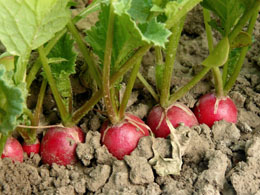Growing organic vegetables at home is not as difficult as it sounds, and is a very healthy option to purchasing them from the market. This article provides some information on how to grow organic vegetables at home.

There is something wonderful about being able to grow your own vegetables that are free from harmful chemical fertilizers and pesticides. Vegetables bought from the store are not necessarily fresh, and do not taste as good as the ones grown at home. A good option is to grow organic vegetables at home, as it only requires some patience and time.
Organic food is that which is allowed to grow naturally without adding chemical fertilizers and pesticides. It is very good for health. All those store-purchased vegetables and fruits which are not labeled as 'organic', contain synthetic chemicals and fertilizers which are used for their growth, and for repelling pests. These vegetables are, therefore, greatly altered in taste, and do not have any of the natural flavors that they are supposed to. So, the decision of organic gardening for your home is a very wise one.
Growing these Vegetables at Home
For growing these vegetables in a patch of land, you first need to purchase organic seeds. If you are unable to find any in your local nursery or greenhouse, then you can order them online. Choose the kind of vegetables that you want to grow. Some good vegetable options for first-time gardeners are beans, squash, potatoes, lettuce, peas, and tomatoes. They require low maintenance, and you will not have much problem growing them.
The next step is finding the right kind of soil. Vegetables require a particular type of soil. You will need one that is mixed with organic compost. Organic compost will provide your plants with all the necessary nutrients needed for proper growth. You can also make this compost by yourself. Do not throw away the fruit and vegetable peels that accumulate in your home, instead, mix them in the soil. Within a week or two, the peels will decompose in the soil, and your organic compost will be ready.
Before planting the seeds, prepare the soil by digging it up with a spade. This will enable aeration and also provide proper drainage. Choose vegetables that are easy to grow. Some seeds like potatoes, onions, parsnips, and tomatoes, can be planted directly in the ground. Other plants like snap peas, beans, and cherry tomatoes, need to be planted indoors in small pots, first, and kept in the windowsill to allow the seeds to germinate. When the seedlings develop, they can be taken out of the pot and replanted in your garden. Water the plants regularly. Climber plants will require a support to grow. So, fix some tall wooden poles in the soil for them to climb on.
Growing these Vegetables in Pots
For those who do not have the required space to make a garden, growing organic vegetables in pots and containers is the next best option. For this, you need medium to large sized pots (terracotta pots work well) which have holes at the bottom for drainage. You can also use discarded cans, wooden crates, and containers, instead of pots, for planting your vegetables. Container gardening is very popular for vegetables, and small pots and containers can be used for growing cherry tomatoes, spring onions, organic herbs, spinach, and bell peppers. Larger containers can be used for growing vegetables like cabbages, squash, pumpkins, and cucumbers. Use potting soil mixed with organic compost, and make sure that the seeds or plants get adequate sunlight by placing them in the balcony or on the terrace.
Growing vegetables is a lot of fun. There are many benefits of organic farming, and the most important one is that you get fruits and vegetables that are completely free of harmful chemicals and pesticides.






 There is something wonderful about being able to grow your own vegetables that are free from harmful chemical fertilizers and pesticides. Vegetables bought from the store are not necessarily fresh, and do not taste as good as the ones grown at home. A good option is to grow organic vegetables at home, as it only requires some patience and time.
There is something wonderful about being able to grow your own vegetables that are free from harmful chemical fertilizers and pesticides. Vegetables bought from the store are not necessarily fresh, and do not taste as good as the ones grown at home. A good option is to grow organic vegetables at home, as it only requires some patience and time.